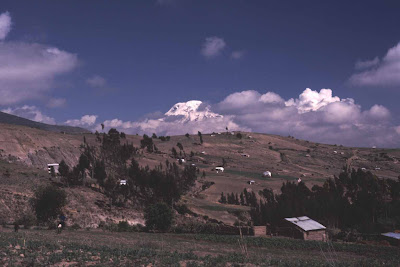Objective: My final project is a lesson on melting terrestrial ice and its effects on the planet. The students will come away with a greater understanding of the causes and effects of melting terrestrial ice and the impacts this will have on Alaskans, both Native and non-Native.
 |
| Photo credit: Teacher's Domain |
Rationale: The reason for teaching this lesson - and the unit of which it is a part - is to help students see the connection between Western science, Native ways of knowing and the real world. It is also to make the students aware of a very real and controversial topic that will affect their lives in many ways, for decades to come.
 |
| Photo credit: Teacher's Domain |
The meat and potatoes.
 The lesson will start with a quick review of melting sea ice, which was addressed in the previous lesson. This will be followed by a viewing of the video Arctic Climate Perspectives that is an excellent comparison of Western scientific knowledge and Native knowledge as well as a very good demonstration of how global warming affects the Inupiat people of Barrow, Alaska. This will be followed by an informal class survey on the allotment of 1000 snowflakes and a subsequent visit on the smartboard to the USGS website page on glaciers and the answers to the 1000 snowflakes survey. Then, a viewing of the Extreme Ice Survey video on the Mendenhall Glacier will be followed by
The lesson will start with a quick review of melting sea ice, which was addressed in the previous lesson. This will be followed by a viewing of the video Arctic Climate Perspectives that is an excellent comparison of Western scientific knowledge and Native knowledge as well as a very good demonstration of how global warming affects the Inupiat people of Barrow, Alaska. This will be followed by an informal class survey on the allotment of 1000 snowflakes and a subsequent visit on the smartboard to the USGS website page on glaciers and the answers to the 1000 snowflakes survey. Then, a viewing of the Extreme Ice Survey video on the Mendenhall Glacier will be followed bya visit to the Documenting Glacial Change interactive site.

 After examining all this background material, we will discuss the day's assignment: mapping the coastline of the Kenai Peninsula taking different amounts of sea-level rise into account. As an example, we will visit the interactive site, Mountain of Ice: If The Ice Melts and view changing coastlines of Florida, as well as the map of Antarctica. We will also go back to the USGS site and view the Glaciers and Sea Level page. We will record the change in sea levels for the various scenarios of glacial melt. Then, the class will be broken into groups. Each group will be given two topographical maps, either covering the northwestern half or the southeastern half of the Kenai Peninsula. Some groups will be asked to map the coastline if a 20-foot sea level rise occurs due to Greenland's glaciers melting, while others will be asked to map the coastline if a 240-foot sea level rise occurs due to Antarctica's glaciers melting. With colored pencils, the new ocean levels will be filled in in blue. This may take a second class period to be completed and will be followed by individual short essays on how the various heights of sea-level change will affect life on the Peninsula, including subsistence hunting and fishing.
After examining all this background material, we will discuss the day's assignment: mapping the coastline of the Kenai Peninsula taking different amounts of sea-level rise into account. As an example, we will visit the interactive site, Mountain of Ice: If The Ice Melts and view changing coastlines of Florida, as well as the map of Antarctica. We will also go back to the USGS site and view the Glaciers and Sea Level page. We will record the change in sea levels for the various scenarios of glacial melt. Then, the class will be broken into groups. Each group will be given two topographical maps, either covering the northwestern half or the southeastern half of the Kenai Peninsula. Some groups will be asked to map the coastline if a 20-foot sea level rise occurs due to Greenland's glaciers melting, while others will be asked to map the coastline if a 240-foot sea level rise occurs due to Antarctica's glaciers melting. With colored pencils, the new ocean levels will be filled in in blue. This may take a second class period to be completed and will be followed by individual short essays on how the various heights of sea-level change will affect life on the Peninsula, including subsistence hunting and fishing.












































